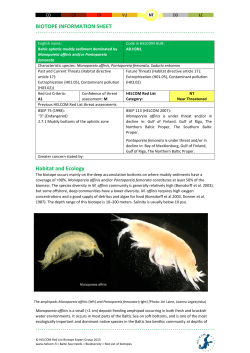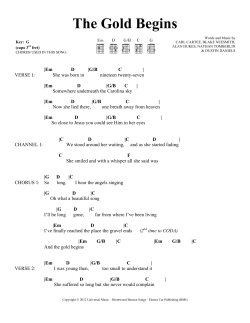
HELCOM Red List AA.E1C4
BIOTOPE INFORMATION SHEET English name: Code in HELCOM HUB: Baltic photic shell gravel dominated by kelp AA.E1C4 Characteristic species: Saccharina latissima, Laminaria digitata, Laminaria hyperborea Past and Current Threats (Habitat directive Future Threats (Habitat directive article 17): article 17): Climate change (ocean acidification M01.04), Eutrophication (H01.05), Contaminant pollution Climate change (ocean acidification M01.04), (H03), Fishing (bottom trawling F02.02.01), Eutrophication (H01.05), Contaminant pollution Construction (offshore construction work D03.03, (H03), Fishing (bottom trawling F02.02.01), oil and gas exploration and exploitation C02, sand Construction (offshore construction work and gravel extraction C01.01, Mining and D03.03, oil and gas exploration and exploitation quarrying (oil and gas exploration and C02, sand and gravel extraction C01.01, Mining exploitation C02), Random threat factors (–) and quarrying(oil and gas exploration and exploitation C02) Red List Criteria: Confidence of threat B1a(ii) assessment: L Previous HELCOM Red List threat assessments BSEP 75 (HELCOM 1998): “?” No data available 2.6.2 Sublittoral shell gravel bottoms of the photic zone Greater concern stated by: HELCOM Red List Category: NT Near Threatened BSEP 113 (HELCOM 2007): Shell gravel bottoms are under threat and/or in decline everywhere, where they occur. Habitat and Ecology The biotope consists of submerged perennial kelp species. The claw-like holdfast of the kelp is attached to shell gravel, mainly Arctica spp. or Mya spp. shells, occurring in the photic zone. Mytilus shells are excluded from this substrate type. Kelp constitutes at least 50% of the biovolume. Characteristic species are Saccharina latissima, Laminaria digitata and to a lesser extent Laminaria hyperborea. The particular species dominance depends mainly on the salinity gradient (Schwenke 1964). The kelp biotope exists only in the Western and to a lower extent also in the Southern Baltic Sea according to the distribution range of the kelp species (HELCOM 2009). Laminaria hyperborea, as a pure marine species, occurs only in the Kattegat and the Northern Belt region (>25 psu). Laminaria digitata (oarweed) is distributed to Western Mecklenburg Bay/Fehmarn (12–15 psu). Saccharina latissima (sugar kelp) has the widest distribution range with findings up to the island of Bornhom (around 10 psu) Saccharina latissima mixed with red algae attached to Arctica islandica shells (left). Holdfast with different epibenthic species: several sponges , ascidians and some red algae (right)(Photo: Karin Fürhaupter, MariLim GmbH) © HELCOM Red List Biotope Expert Group 2013 www.helcom.fi > Baltic Sea trends > Biodiversity > Red List of biotopes BIOTOPE INFORMATION SHEET (Schwenke 1964). Saccharina latissima reproductive germlings need a salinity over 11 psu to survive (Peteiro & Sánchez 2012). In contrast to pure marine environments, for example the coast of Norway and Great Britain, the kelp biotopes in the Baltic Sea do not grow in the intertidal or the uppermost sublittoral zone. In brackish conditions the depth distribution of the biotope is shifted to deeper areas (with higher salinities = brackish submergence after Remane, 1955). At its eastern distribution limit kelp biotopes mark the lower depth limit of vegetation and therefore the photic zone. They occur down to 30 –35 meters depending on the eutrophication level and availability of suitable substrates. Kelp biotopes are not sensitive to exposure. Due to the deeper distribution in the Baltic Sea they are known to occur at exposed (Kattegat) and moderately exposed sites (Bay of Mecklenburg) in terms of wave action. Kelp beds form an important biotope for other algae, including the green algae Chaetomorpha melagonium, the red algae Delesseria sanguinea, Phycodrys rubens and Brongniartella byssoides and the annual brown algae Desmarestia aculeata, which are often growing entangled around the holdfasts. Many other species live attached to the kelp canopy, like hydrozoans (Clava multicornis, Obelia geniculata) and bryozoans (like Electra pilosa, Membranipora membranacea, Cribrilina spp.) or are grazing on the stipe and blades (Hydrobia spp., Rissoa spp.). The claw-like holdfast shelters polychaetes, sponges and ascidians (Dendrodoa grossularia). Kelp also constitutes an important biotope for many fish, such as goldsinny‑wrasse (Ctenolabrus rupestris) and two‑spotted goby (Gobisculus flavescens) (OCEANA 2011). Shellgravel bottom in Germany (Courtesy of IOW) © HELCOM Red List Biotope Expert Group 2013 www.helcom.fi > Baltic Sea trends > Biodiversity > Red List of biotopes BIOTOPE INFORMATION SHEET Distribution and status in the Baltic Sea region The kelp biotopes are common from Kattegat to the Bornholm Basin. The spatial restriction to the Western and Southern Baltic Sea is due to the salinity requirements of the dominant kelp species. The higher the salinities, the higher the diversity of the biotope with respect to accompanying plant species and inhabiting invertebrate and fish communities. The distribution map indicates the areas where the biotope can occur in a 100x100 km grid. © HELCOM Red List Biotope Expert Group 2013 www.helcom.fi > Baltic Sea trends > Biodiversity > Red List of biotopes BIOTOPE INFORMATION SHEET Description of Major threats Observed declines of kelp biotopes are caused by eutrophication. With decreasing light penetration the depth limit is reduced. An increase of the upper distribution limit is not possible due to the too low salinities. Therefore the vertical depth interval, suitable for growth, is restricted. Increasing siltation caused by eutrophication as well as sedimentation due to dumping or marine offshore constructions may prevent germling attachment to the substrate. Also bottom trawling, oil and gas exploration and exploitation, sand and gravel extraction and offshore installations are threatening this habitat (HELCOM Website). Assessment justification B1a(ii) The classification of the biotope is caused by rarity of the specific substrate “shell gravel”, as the other kelp biotopes are not threatened. The assessment justification refers therefore to that of the “shell 2 gravel biotope.” EOO is ≤ 55,000 km and climate change and eutrophication that affect the environmental quality negatively are predicted and inferred to continue. The necessary environmental conditions (specific bottom morphology and currents) to enable shell gravel bottoms exist only within very few and spatially restricted localities and the conditions to enable kelp species to grow on the shells (light availability, salinity) restricts the spatial distribution of this biotope furthermore. Recommendations for actions to conserve the biotope All actions to reduce physical disturbance of shell gravel bottoms and eutrophication in the Baltic Sea are important for the conservation of this biotope dominated by kelp. Appointing areas where the biotope is known to occur as protected sites, where bottom trawling, and exploitation of marine soil resources like oil, gas, sand or gravel is prohibited, would constitute an effective conservation measure. Common names References (HELCOM Website) http://www.helcom.fi/environment2/biodiv/endangered/Biotopes/en_GB/Shell_gravel_bottoms/ HELCOM (2009). Biodiversity in the Baltic Sea. An integrated thematic assessment on biodiversity and nature conservation in the Baltic Sea. Baltic Sea Environmental Proceedings No. 116B. Helsinki Commission, Helsinki. 189pp. Available at: http://www.helcom.fi/stc/files/Publications/Proceedings/bsep116B.pdf HELCOM (1998). Red List of marine and coastal biotopes and biotopes complexes of the Baltic Sea, Belt Sea and Kattegat. Baltic Sea Environmental Proceedings No. 75. Helsinki Commission, Helsinki. 115pp. Available at: http://www.helcom.fi/stc/files/Publications/Proceedings/bsep75.pdf OCEANA (2011). Conservation proposals for ecologically important areas in the Baltic Sea. http://oceana.org/sites/default/files/reports/OCEANA_Baltic_report_2011_ENG.pdf Peteiro, C., Sánchez, N. (2012). Comparing Salinity Tolerance in Early Stages of the Sporophytes of a Non-indigenous Kelp (Undaria pinnatifida) and a Native Kelp (Saccharina latissima). Russian Journal of Marine Biology 38: 197-200. Schwenke H. 1964. Vegetation und Vegetationsbedingungen in der westlichen Ostsee (Kieler Bucht). Kieler Meeresforschungen 20, 1:157-168. © HELCOM Red List Biotope Expert Group 2013 www.helcom.fi > Baltic Sea trends > Biodiversity > Red List of biotopes
© Copyright 2024









